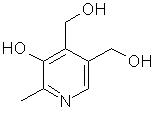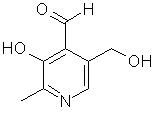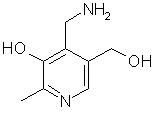

 |
 |
 Vitamin B6 Crystals Copied without permission from Roche Product Information |
Vitamin B6 (Pyridoxine)Vitamin B6, or pyridoxine is one of the water soluble B-vitamins. By replacing the -CH2OH group on position 4 of the pyridoxine molecule with -CH2NH2 and -CHO respectively, two related compounds, pyridoxamine and pyridoxal can be formed which are also vitamin active.Did You Know? The full chemical name of pyridoxine is 2-methyl-3-hydroxy-4,5-bis(hydroxy-methyl)pyridine! Top Chemical Structures Fig.1 The Chemical Structure of Pyridoxol (Pyridoxine) 3D Structure of Pyridoxol  Fig.2 The Chemical Structure of Pyridoxal  Fig.3 The Chemical Structure of Pyridoxamine Top Principal Sources in FoodIn food, Vitamin B6 is usually bound to protein, pyridoxol being the prominent form in plants, and pyridoxal and pyridoxamine in animal products. Major dietary sources of pyridoxine include:
Vitamin B6 in the BodyIn the body, pyridoxine is normally stored as pyridoxal-5-phosphate (PLP), the coenzyme form of the vitamin. It is needed for:
StabilityVitamin B6 is quite stable to heat but is sensitive to air, UV light and alkali.Top |